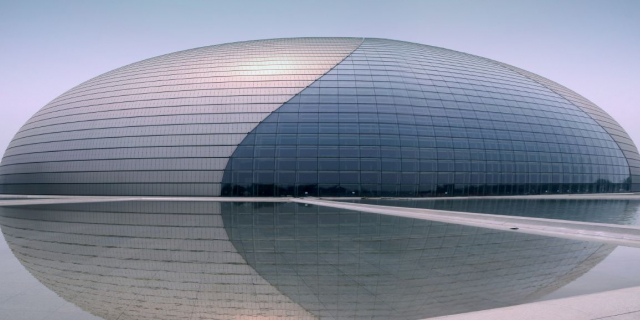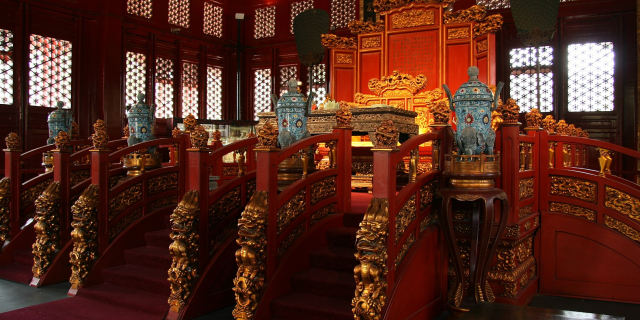天安门广场
( Tiananmen Square )
Tiananmen Square or Tian'anmen Square () is a city square in the city center of Beijing, China, named after the eponymous Tiananmen ("Gate of Heavenly Peace") located to its north, which separates it from the Forbidden City. The square contains the Monument to the People's Heroes, the Great Hall of the People, the National Museum of China, and the Mausoleum of Mao Zedong. Mao Zedong proclaimed the founding of the People's Republic of China in the square on October 1, 1949; the anniversary of this event is still observed there. The size of Tiananmen Square is 765 x 282 meters (215,730 m2 or 53.31 acres). It has great cultural significance as it was the site of several important events in Chinese history.
Outside China, the square is best known for the 1989 protests and massacre that ended with a military crackdown due to international media coverage, internet and global connectivity, its political impli...Read more
Tiananmen Square or Tian'anmen Square () is a city square in the city center of Beijing, China, named after the eponymous Tiananmen ("Gate of Heavenly Peace") located to its north, which separates it from the Forbidden City. The square contains the Monument to the People's Heroes, the Great Hall of the People, the National Museum of China, and the Mausoleum of Mao Zedong. Mao Zedong proclaimed the founding of the People's Republic of China in the square on October 1, 1949; the anniversary of this event is still observed there. The size of Tiananmen Square is 765 x 282 meters (215,730 m2 or 53.31 acres). It has great cultural significance as it was the site of several important events in Chinese history.
Outside China, the square is best known for the 1989 protests and massacre that ended with a military crackdown due to international media coverage, internet and global connectivity, its political implications, and other factors. Within China, little, if anything about the massacre is known by most Chinese due to strict censorship of knowledge of the crackdowns by the Chinese Communist Party.
 Tiananmen Square in the early 20th century, viewed from Zhengyangmen Gate (Qianmen Gate) with the Gate of China, later removed in 1954 to make room for the present-day Mao Zedong Mausoleum. The "corridor of a thousand steps" is visible (behind the Gate of China) and Tiananmen Gate is in the distance.
Tiananmen Square in the early 20th century, viewed from Zhengyangmen Gate (Qianmen Gate) with the Gate of China, later removed in 1954 to make room for the present-day Mao Zedong Mausoleum. The "corridor of a thousand steps" is visible (behind the Gate of China) and Tiananmen Gate is in the distance. Tiananmen Square during the May Fourth movement in 1919(video) Two shots of the namesake gate to the north followed by a shot of inside Tiananmen Square in 2017
Tiananmen Square during the May Fourth movement in 1919(video) Two shots of the namesake gate to the north followed by a shot of inside Tiananmen Square in 2017The Tiananmen ("Gate of Heavenly Peace"), a gate in the wall of the Imperial City, was built in 1417 during the Ming dynasty. In the 17th century, fighting between Li Zicheng's rebel forces and the forces of the Manchu-led Qing dynasty caused heavy damage to, or even destroyed, the gate. Tiananmen Square was designed and built in 1651 and was enlarged fourfold in the 1950s.[1][2]
The gate historically known as the "Great Ming Gate", the southern gate to the Imperial City stands near the center of the square. It was renamed the "Great Qing Gate" during the Qing dynasty, and the "Gate of China" during the Republican era. Unlike the other gates in Beijing, such as the Tiananmen and the Zhengyang Gate, this was a purely ceremonial gateway, with three arches but no ramparts, similar in style to the ceremonial gateways found in the Ming tombs. This gate had a special status as the "Gate of the Nation", as can be seen from its successive names. It normally remained closed, except when the emperor passed through. Commoner traffic was diverted to side gates at the western and eastern ends of the square, respectively. Because of this diversion in traffic, a busy marketplace, called "Chess Grid Streets", was developed in the large fenced square to the south of this gate.[citation needed]
19th centuryIn 1860, during the Second Opium War, when British and French troops occupied Beijing, they pitched camp near the gate and briefly considered burning down the gate and the Forbidden City. Ultimately, they decided to spare the Forbidden City and instead burn down the Old Summer Palace. The Xianfeng Emperor eventually agreed to let Western powers barrack troops – and later establish diplomatic missions – in the area, hence there was the Legation Quarter immediately to the east of the square. When the forces of the Eight-Nation Alliance besieged Beijing during the Boxer Rebellion in 1900, they badly damaged the office complexes and burnt down several ministries. After the Boxer Rebellion ended, the area became a space for the Eight-Nation Alliance to assemble their military forces.[citation needed]
20th centuryIn 1954, the Gate of China was demolished, allowing for the enlargement of the square. In November 1958, a major expansion of Tiananmen Square started, which was completed after only 11 months, in August 1959. This followed the vision of Mao Zedong to make the square the largest and most spectacular in the world and intended to hold over 500,000 people. In that process, a large number of residential buildings and other structures were demolished.[3] On its southern edge, the Monument to the People's Heroes has been erected. Concomitantly, as part of the Ten Great Buildings constructed between 1958 and 1959 to commemorate the ten-year anniversary of the People's Republic of China (PRC), the Great Hall of the People and the Revolutionary History Museum (now the National Museum of China) were erected on the western and eastern sides of the square.[3]
For the first decade of the PRC, each National Day (October 1) was marked by a large military parade in Tiananmen Square, in conscious emulation of the annual Soviet celebrations of the Bolshevik Revolution. After the disaster of the Great Leap Forward, the CCP decided to cut costs and have only smaller annual National Day celebrations in addition to a large celebration with a military parade every 10 years. However, the chaos of the Cultural Revolution almost prevented such an event from taking place on National Day in 1969 but did take place in 1966 and 1970.[citation needed]
In 1971, large portraits of Karl Marx, Friedrich Engels, Vladimir Lenin, Joseph Stalin, Sun Yat-sen, and Mao Zedong were erected in the square, painted by artist Ge Xiaoguang, who is also responsible for producing the famous portrait of Mao that hangs over the Gate of Heavenly Peace. In 1980, with the downgrading of political ideology following Mao's death, the portraits were taken down and thenceforth only brought out on Labor Day (May 1) and National Day.[citation needed]
Ten years later, in 1979, the CCP again decided against a large-scale celebration, coming at a time when Deng Xiaoping was still consolidating power and China had suffered a rebuff in a border war with Vietnam early in the year. By 1984, with the situation much improved and stabilized, the PRC held a military parade for the first time since 1959. The aftermath of the Tiananmen Square massacre prevented any such activities in October 1989, but military parades have been held in 1999 and 2009, on the 50th and 60th anniversaries of the PRC's founding.[4]
One year after Mao's death, a mausoleum was built near the site of the former Gate of China along the main north–south axis of the square. In connection with this project, the square was further increased in size to become fully rectangular and being able to accommodate 600,000 people.[3]
1989 Tiananmen Square protests massacreIn 1989, Tiananmen Square was the site of the 1989 Tiananmen Square protests and massacre in which the People's Liberation Army cracked down on a student protest on the square that had the stated purpose of calling for political liberalization and greater respect for human rights, killing an unknown number of protesters estimated to range from a few hundred to a few thousand.[5][6][7]
The urban context of the square was altered in the 1990s with the construction of National Grand Theater in its vicinity and the expansion of the National Museum.[3]

































Add new comment